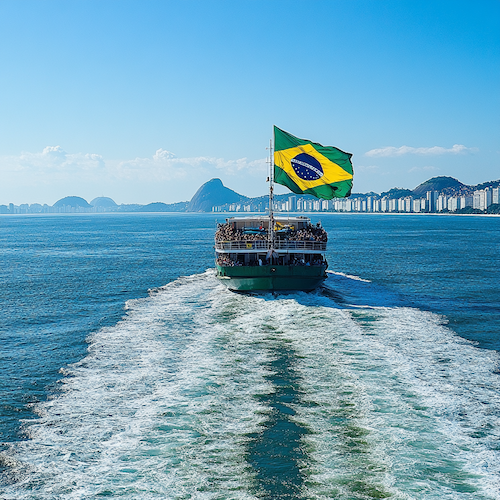2024/08/30
Shipping to Brazil can feel like a financial black hole. With high costs and complicated logistics, many wonder why sending packages to this South American giant is so expensive. Whether you’re a business looking to expand into Brazilian markets or an individual sending a gift, understanding the factors driving these costs is crucial. This article breaks down the reasons behind the hefty price tags associated with shipping to Brazil and offers some practical advice to manage these expenses.

Brazil, the largest country in South America, spans over 8.5 million square kilometers. Its vast size means that shipping from one part of Brazil to another can be as costly as shipping from overseas. Additionally, Brazil's remote locations and underdeveloped regions pose significant challenges. Economic instability and fluctuating exchange rates further complicate matters, making shipping costs unpredictable and often high.
One of the primary reasons for high shipping costs to Brazil is its infrastructure. While Brazil boasts several large ports, many are congested and outdated. The lack of modern facilities and efficient handling processes can lead to delays and increased costs. Inside Brazil, the transportation network is uneven. Major cities have better infrastructure, but rural areas can be poorly connected, increasing shipping expenses.
Brazil's complex regulatory environment is another key factor. The country has stringent import regulations that can lead to lengthy processing times and additional fees. The customs process in Brazil is notorious for its bureaucracy, often requiring extensive paperwork and compliance with a myriad of regulations. These factors contribute to delays and increased costs, both for businesses and individuals.
Import taxes in Brazil are notoriously high. The country imposes various taxes and tariffs on imported goods, which can significantly inflate shipping costs. The "Imposto de Importação" (Import Tax) and "Imposto sobre Produtos Industrializados" (Tax on Industrialized Products) are examples of levies that can add up quickly. These taxes are often a major contributor to the overall cost of shipping to Brazil.
Shipping logistics in Brazil are complex and can be costly. The country’s vast size and varied infrastructure mean that delivery times can be unpredictable. Goods may spend a significant amount of time in transit, contributing to higher costs. Efficient logistics are crucial for reducing costs, but many regions in Brazil still face logistical challenges.
The value of the Brazilian real, Brazil’s currency, fluctuates frequently. This volatility can impact shipping costs, especially for international transactions. When the real weakens against major currencies like the US dollar or the euro, shipping costs in local terms can increase. Conversely, a stronger real might offer some relief, but currency fluctuations make it difficult to predict costs accurately.
The choice of shipping carrier can greatly affect costs. Different carriers offer various services and pricing structures. While some may offer lower base rates, additional fees for services like expedited delivery or customs handling can drive up the total cost. It’s essential to compare carriers and their offerings to find the most cost-effective solution for shipping to Brazil.
The size and weight of packages play a significant role in shipping costs. Larger and heavier packages are more expensive to ship, and this is particularly true for international shipments. To manage costs, it’s advisable to optimize packaging to reduce size and weight where possible. This can help lower shipping rates and make the process more economical.
Shipping insurance is vital when sending goods to Brazil. The added cost of insurance can be a small price to pay compared to the potential loss or damage of valuable items. Risk management practices can also help mitigate potential issues, such as theft or damage, which can further inflate shipping costs.
Recent policy changes and trends can impact shipping costs. For instance, Brazil has made efforts to modernize its port infrastructure and streamline customs processes. Staying informed about these changes can help businesses and individuals adapt and potentially reduce shipping expenses.
When comparing shipping costs to Brazil with other countries, it becomes evident that Brazil's costs are relatively high. Factors such as import taxes, regulatory hurdles, and infrastructure challenges contribute to these elevated costs. Understanding how Brazil stacks up against its neighbors can provide insight into the unique challenges of shipping to this country.
Asiafly strongly focus on Brazil Parcel Forwarding, feel free to contact us!
To manage and reduce shipping costs to Brazil, consider the following tips:
Optimize Packaging: Use compact, lightweight packaging to reduce size and weight.
Choose the Right Carrier: Compare rates and services from different carriers to find the best option.
Understand Taxes and Duties: Be aware of import taxes and tariffs to factor them into your cost calculations.
Leverage Shipping Software: Utilize software tools to track and manage shipping efficiently.
Stay Updated: Keep abreast of changes in regulations and infrastructure improvements that might affect costs.
Shipping to Brazil can be an expensive and complex endeavor, driven by factors ranging from infrastructure challenges to high taxes and tariffs. By understanding these factors and employing strategies to manage costs, you can make shipping to Brazil more manageable and cost-effective. Whether you're a business looking to expand or an individual sending a package, navigating these challenges is key to a smoother shipping experience.